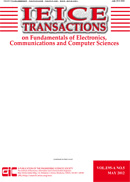Volume E106.A, Issue 9
Displaying 1-25 of 25 articles from this issue
- |<
- <
- 1
- >
- >|
Special Section on Discrete Mathematics and Its Applications
-
2023Volume E106.AIssue 9 Pages 1081
Published: September 01, 2023
Released on J-STAGE: September 01, 2023
Download PDF (208K) -
Article type: PAPER
Subject area: Algorithms and Data Structures
2023Volume E106.AIssue 9 Pages 1082-1091
Published: September 01, 2023
Released on J-STAGE: September 01, 2023
Advance online publication: April 03, 2023Download PDF (1847K) -
Article type: PAPER
Subject area: Algorithms and Data Structures
2023Volume E106.AIssue 9 Pages 1092-1099
Published: September 01, 2023
Released on J-STAGE: September 01, 2023
Advance online publication: March 06, 2023Download PDF (619K) -
Article type: PAPER
Subject area: Algorithms and Data Structures
2023Volume E106.AIssue 9 Pages 1100-1110
Published: September 01, 2023
Released on J-STAGE: September 01, 2023
Advance online publication: March 07, 2023Download PDF (1269K) -
Article type: PAPER
Subject area: Algorithms and Data Structures
2023Volume E106.AIssue 9 Pages 1111-1118
Published: September 01, 2023
Released on J-STAGE: September 01, 2023
Advance online publication: March 20, 2023Download PDF (1678K) -
Article type: PAPER
Subject area: Cryptography and Information Security
2023Volume E106.AIssue 9 Pages 1119-1130
Published: September 01, 2023
Released on J-STAGE: September 01, 2023
Advance online publication: March 07, 2023Download PDF (891K) -
Article type: PAPER
Subject area: Cryptography and Information Security
2023Volume E106.AIssue 9 Pages 1131-1140
Published: September 01, 2023
Released on J-STAGE: September 01, 2023
Advance online publication: February 07, 2023Download PDF (1163K) -
Article type: PAPER
Subject area: Cryptography and Information Security
2023Volume E106.AIssue 9 Pages 1141-1163
Published: September 01, 2023
Released on J-STAGE: September 01, 2023
Advance online publication: March 13, 2023Download PDF (949K) -
Article type: PAPER
Subject area: Cryptography and Information Security
2023Volume E106.AIssue 9 Pages 1164-1176
Published: September 01, 2023
Released on J-STAGE: September 01, 2023
Advance online publication: March 07, 2023Download PDF (1768K) -
Article type: PAPER
Subject area: Cryptography and Information Security
2023Volume E106.AIssue 9 Pages 1177-1188
Published: September 01, 2023
Released on J-STAGE: September 01, 2023
Advance online publication: April 03, 2023Download PDF (3523K) -
Article type: LETTER
Subject area: Algorithms and Data Structures
2023Volume E106.AIssue 9 Pages 1189-1190
Published: September 01, 2023
Released on J-STAGE: September 01, 2023
Advance online publication: December 07, 2022Download PDF (236K) -
Article type: LETTER
Subject area: Algorithms and Data Structures
2023Volume E106.AIssue 9 Pages 1191-1194
Published: September 01, 2023
Released on J-STAGE: September 01, 2023
Advance online publication: March 06, 2023Download PDF (276K)
Special Section on Image Media Quality
-
2023Volume E106.AIssue 9 Pages 1195
Published: September 01, 2023
Released on J-STAGE: September 01, 2023
Download PDF (102K) -
Article type: INVITED PAPER
Subject area: Vision
2023Volume E106.AIssue 9 Pages 1196-1201
Published: September 01, 2023
Released on J-STAGE: September 01, 2023
Advance online publication: June 16, 2023Download PDF (3480K) -
Article type: PAPER
Subject area: Intelligent Transport System
2023Volume E106.AIssue 9 Pages 1202-1210
Published: September 01, 2023
Released on J-STAGE: September 01, 2023
Advance online publication: June 27, 2023Download PDF (4952K) -
Article type: LETTER
Subject area: Image
2023Volume E106.AIssue 9 Pages 1211-1215
Published: September 01, 2023
Released on J-STAGE: September 01, 2023
Advance online publication: June 13, 2023Download PDF (602K) -
Article type: LETTER
Subject area: Image
2023Volume E106.AIssue 9 Pages 1216-1219
Published: September 01, 2023
Released on J-STAGE: September 01, 2023
Advance online publication: June 13, 2023Download PDF (2318K) -
Article type: LETTER
Subject area: Vision
2023Volume E106.AIssue 9 Pages 1220-1223
Published: September 01, 2023
Released on J-STAGE: September 01, 2023
Advance online publication: June 27, 2023Download PDF (513K)
Regular Section
-
Article type: PAPER
Subject area: Digital Signal Processing
2023Volume E106.AIssue 9 Pages 1224-1233
Published: September 01, 2023
Released on J-STAGE: September 01, 2023
Advance online publication: February 28, 2023Download PDF (1963K) -
Article type: PAPER
Subject area: Nonlinear Problems
2023Volume E106.AIssue 9 Pages 1234-1240
Published: September 01, 2023
Released on J-STAGE: September 01, 2023
Advance online publication: March 20, 2023Download PDF (1177K) -
Article type: PAPER
Subject area: VLSI Design Technology and CAD
2023Volume E106.AIssue 9 Pages 1241-1250
Published: September 01, 2023
Released on J-STAGE: September 01, 2023
Advance online publication: March 03, 2023Download PDF (1164K) -
Article type: PAPER
Subject area: Cryptography and Information Security
2023Volume E106.AIssue 9 Pages 1251-1262
Published: September 01, 2023
Released on J-STAGE: September 01, 2023
Advance online publication: March 06, 2023Download PDF (3250K) -
Article type: LETTER
Subject area: Digital Signal Processing
2023Volume E106.AIssue 9 Pages 1263-1267
Published: September 01, 2023
Released on J-STAGE: September 01, 2023
Advance online publication: March 14, 2023Download PDF (1485K) -
Article type: LETTER
Subject area: Cryptography and Information Security
2023Volume E106.AIssue 9 Pages 1268-1271
Published: September 01, 2023
Released on J-STAGE: September 01, 2023
Advance online publication: March 09, 2023Download PDF (167K) -
Article type: LETTER
Subject area: Coding Theory
2023Volume E106.AIssue 9 Pages 1272-1276
Published: September 01, 2023
Released on J-STAGE: September 01, 2023
Advance online publication: February 24, 2023Download PDF (307K)
- |<
- <
- 1
- >
- >|
